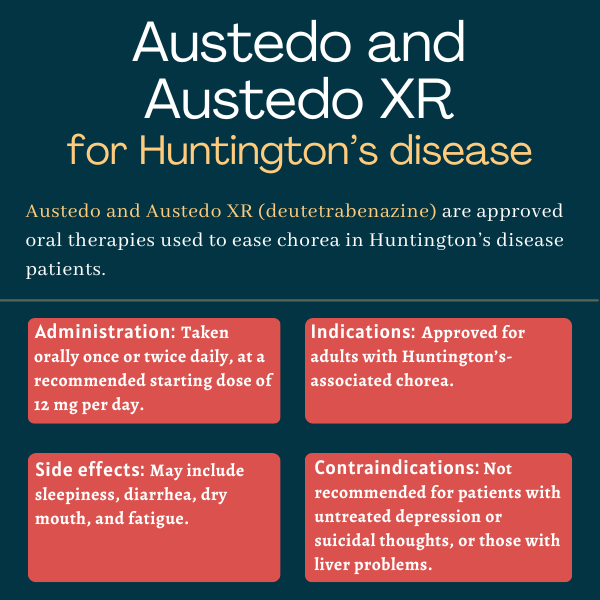Austedo and Austedo XR (deutetrabenazine) for Huntington’s disease
Last updated June 3, 2024, by Marta Figueiredo, PhD

What is Austedo for Huntington’s disease?
Austedo (deutetrabenazine) is an approved oral therapy used to reduce chorea, or involuntary and uncontrolled movements associated with Huntington’s disease, in adults.
The therapy also is available in the U.S. as an extended-release formulation called Austedo XR, which is designed to offer a more convenient dosing regimen to patients.
Both formulations were developed by Teva Pharmaceuticals, and also are approved for adults with another movement disorder called tardive dyskinesia.
Therapy snapshot
| Brand name: | Austedo and Austedo XR |
| Chemical name: | Deutetrabenazine |
| Usage: | Used to reduce chorea associated with Huntington’s disease |
| Administration: | Oral tablets |
How does Austedo work?
Involuntary jerking and writhing movements known as chorea are a hallmark of Huntington’s, an inherited neurodegenerative disease. About 90% of Huntington’s patients experience these abnormal movements, which can affect any part of the body and interfere with walking, posture, swallowing, and speech.
Abnormally high levels of dopamine, a neurotransmitter involved in the regulation of muscle movement, are thought to be behind chorea in Huntington’s. A neurotransmitter is a signaling molecule used by nerve cells to communicate with each other and with muscle cells.
Austedo is a small molecule that suppresses the activity of vesicular monoamine transporter 2 (VMAT2), a protein responsible for the transport and recycling of dopamine and certain other neurotransmitters — key processes in nerve cell communication.
Its exact mechanism of action is not completely understood, but researchers believe that its ability to block VMAT2 reduces the amount of dopamine that’s released by nerve cells, which is expected to ease chorea.
Deutetrabenazine, the active ingredient in both Austedo and Austedo XR, is structurally similar to Xenazine (tetrabenazine), the first approved therapy for Huntington’s-associated chorea.
However, the newer molecule is deuterated, meaning it was modified with a nontoxic form of hydrogen called deuterium, which makes it harder to break down. This allows deutetrabenazine to remain in the body longer, and to reduce dosing frequency relative to Xenazine — which is taken as many as three times a day.
While Austedo is administered twice daily, Austedo XR is an extended-release formulation that allows once-daily dosing.
Who can take Austedo?
Austedo was approved by the U.S. Food and Drug Administration (FDA) in April 2017 for treating adults with Huntington’s-associated chorea. The decision made it the first new therapy available for such indication in nearly a decade, and the first deuterated medication approved in the country.
In the following years, Austedo also became available for people with Huntington’s-associated chorea in several other countries, including Australia, Brazil, China, and Israel.
It is not approved in the European Union or in the U.K., but some patients in those countries may be eligible for treatment as part of an Unsolicited Ethical Unlicensed Medicine program that aims to provide access to therapies approved in other countries.
Austedo XR was granted FDA approval for chorea in adults with Huntington’s in February 2023. This form is not yet approved in any other countries.
Who should not take Austedo?
Austedo and Austedo XR are contraindicated, or not recommended, for certain patients:
- People with untreated or inadequately treated depression, or with thoughts of suicide, should not take these medications. The therapies carry a boxed warning noting they may increase the risk of depression and suicidal thoughts and behaviors in people with Huntington’s. Therefore, caution is recommended when treating patients with a history of depression, suicidal thoughts, or suicide attempts.
- Patients with liver problems are not recommended to use these medications, as the therapies are mostly eliminated by that organ.
- People receiving treatment with monoamine oxidase inhibitors (MAOIs), a type of antidepressant, should not take these medicines. The therapies should not be taken in combination nor in the first two weeks after MAOI treatment discontinuation.
- Patients on reserpine, an old medication used to treat high blood pressure and also to reduce Huntington’s abnormal movements, should not be given these treatments. Those switching from reserpine to the Austedo formulations should wait 20 or more days after the last reserpine dose to do so.
- Those on other approved treatments for Huntington’s-associated chorea, such as Xenazine or Ingrezza (valbenazine), should not also take this medication. If switching from Xenazine to Austedo or Austedo XR, patients should take their first dose on the day after Xenazine’s last dose.
The therapies also should be avoided in patients with QT prolongation — an extension of the interval between the heart contracting and relaxing — and a history of arrhythmias, or abnormal heartbeat.
How is Austedo administered?
Both Austedo and Austedo XR are available in the form of round tablets and are taken orally. Austedo tablets come in three dose strengths:
- 6 mg purple-coated tablets with “SD” over “6” printed in black ink on one side
- 9 mg blue-coated tablets printed with “SD” over “9” in black ink on one side
- 12 mg beige-coated tablets with “SD” over “12” printed in black ink on one side.
There are seven available dose strengths for Austedo XR:
- 6 mg gray-coated extended-release tablets, with “Q6” printed in black ink on one side
- 12 mg blue-coated extended-release tablets printed with “Q12” in black ink on one side
- 24 mg purple-coated extended-release tablets with “Q24” printed in black ink on one side
- 30 mg light orange-coated extended-release tablets printed with “Q30” in black ink on one side
- 36 mg light purple-coated extended-release tablets, with “Q36” printed in black ink on one side
- 42 mg orange-coated extended-release tablets printed with “Q42” in black ink on one side
- 48 mg pink-coated extended-release tablets, with “Q48” printed in black ink on one side.
The recommended starting daily dose for both medications is 12 mg: one 6 mg tablet twice a day for Austedo and one 12 mg tablet once daily for Austedo XR. That dose can be upped by 6 mg per week based on the patient’s response to treatment and an ability to tolerate the medication, up to a maximum daily dose of 48 mg.
Austedo tablets should always be taken twice a day, with Austedo XR taken once daily. The regimen for all patients on Austedo XR comprises just one pill a day, regardless of their daily dose, except for those on an 18 mg daily dose, in which case more than one tablet is needed per day to reach that dosage. But according to Teva, clinical trial data showed Austexo XR’s clinically therapeutic doses are between 24 and 48 mg/day, meaning that all patients taking such doses will only have to take one pill per day.
Austedo should be taken with food, while Austedo XR can be taken with or without food. Both medications should be swallowed whole, and neither should be chewed, crushed, or broken.
Patients switching from Austedo to Austedo XR should switch to the same daily dose, but taken only once a day.
Starting doses of Austedo or Austedo XR in patients switching from Xenazine are dependent on the Xenazine dose that was being taken. Dosage can be subsequently adjusted at weekly intervals.
Austedo and Austedo XR’s maximum daily dose should be reduced to 36 mg in patients who are known to have poor activity of CYP2D6 and those taking medications that are strong CYP2D6 suppressors. CYP2D6 is a liver enzyme that’s involved in the metabolism of several medications.
The medications can be discontinued without dose reduction. Patients restarting treatment after an interval of more than one week should undergo the process of dose optimization again. For shorter treatment interruptions, either therapy can be resumed at the prior maintenance dose.

Austedo in clinical trials
The approvals of Austedo for Huntington’s-associated chorea were supported mainly by data from a Phase 3 clinical trial called First-HD (NCT01795859). That study was completed in December 2014.
First-HD
The First-HD study enrolled 90 adults with Huntington’s-associated chorea at multiple sites in North America and Australia. Participants were randomly assigned to take an oral tablet of either Austedo or a placebo, twice daily, for 12 weeks, or about three months.
Austedo was started at a dose of 6 mg per day and optimized based on tolerability, with a maximum dose of 48 mg per day during the first eight weeks. After that, patients received a maintenance, optimal dose for the remaining four weeks, and completed a last visit after a week of no medication.
The trial’s main goal was to evaluate changes in the Unified Huntington’s Disease Rating Scale total maximal chorea (TMC) score, which assesses chorea in the face, mouth/jaw, trunk, and limbs. Higher TMC scores reflect more severe chorea.
The results showed that Austedo-treated patients experienced, on average, a significantly greater reduction in TMC scores than did those on a placebo (4.4 vs. 1.9 points). In both groups, however, scores reverted to their initial values a week after treatment discontinuation.
Austedo’s superiority over the placebo also was observed in terms of Huntington’s symptom lessening, which was more frequently reported in the Austedo group, both by patients (51% vs. 20%) and clinicians (42% vs. 13%).
Compared with patients in the placebo group, those taking Austedo also showed significantly greater improvements in the physical functioning component of the 36-Item Short Form Health Survey, which assesses quality of life. While the placebo group lost about 3.6 points in that component, those on Austedo experienced a 0.7-point improvement.
Open-label extension
Patients completing First-HD had the option to enroll in an open-label study, called ARC-HD (NCT01897896), in which all received Austedo twice a day for as long as three years. Individuals who were responding to a stable dose of Xenazine also were allowed to enter the trial and switch to Austedo.
Data from this trial demonstrated that TMC scores dropped in both patient groups after eight weeks of treatment, although those reductions were more pronounced among patients who had completed First-HD (4.5 vs. 2.1). Chorea scores showed minimal changes from that point onward over treatment.
Ongoing trials
A Phase 2/3 trial (NCT04713982) is assessing Austedo’s effects on speech, joint movement, hand dexterity, balance, and walking in an estimated 30 adults with Huntington’s. The study is being sponsored by and conducted at Vanderbilt University Medical Center, in Nashville.
Austedo XR in clinical trials
The approval of Austedo XR for chorea due to Huntington’s was based mainly on clinical trial data demonstrating the new formulation is therapeutically equivalent to Austedo.
TV50717-BE-10179
A Phase 1 clinical study called TV50717-BE-10179 evaluated the safety and pharmacological properties of Austedo XR (24 mg taken once daily) against Austedo (12 mg taken twice daily) in 262 healthy adults. Participants received each therapy, after a meal, for seven days.
Austedo XR was shown to deliver an equal amount of the active medication compared with the original formulation, and to have comparable pharmacokinetics, which is a treatment’s movement into, through, and out of the body.
Similar to Austedo, the extended-release formulation reached maximum blood concentration within about three hours, but these values were sustained for several hours, allowing for the 24-hour interval between doses.
Austedo XR was also not associated with new safety concerns.
TV50717-PK-10175
Another Phase 1 trial called TV50717-PK-10175 evaluated the dose proportionality of Austedo XR’s three dose strengths (6, 12, and 24 mg) in 116 healthy adults.
Data demonstrated that the pharmacokinetics of one 12 mg Austedo XR tablet was similar to that reported for two 6 mg Austedo tablets, confirming bioequivalence. There was also a dose-proportional exposure to Austedo XR in the blood for all pharmacokinetics parameters and over the recommended dose range (6-48 mg).
Common side effects of Austedo
The most common side effects associated with Austedo and Austedo XR in Huntington’s include:
- somnolence or sleepiness
- diarrhea
- dry mouth
- fatigue.
Depression and suicidal ideation
The prescribing information for Austedo and Austedo XR carries a boxed warning noting that the medications can increase the risk of depression and suicidal thoughts or behaviors, which is already higher than normal in people with Huntington’s.
Before starting treatment, patients and their healthcare team should discuss whether the need for treatment outweighs the risk of depression and suicidal thoughts or actions.
Those starting on Austedo or Austedo XR should be monitored for new or worsening signs of these issues. Patients, as well as their caregivers and families, should be aware of this risk and report any sudden changes in mood, behaviors, thoughts, or feelings to the treating physician, especially in the periods after treatment start and any changes in dose.
Patients with new or worsening signs of depression, suicidal thoughts, and/or behaviors that do not resolve should be immediately evaluated and consider stopping treatment.
Clinical worsening versus side effects
Because Austedo, Austedo XR, and other VMAT2 inhibitors may worsen mood, cognitive function, rigidity, and functional capacity — which are already affected by Huntington’s itself — it may be difficult to distinguish between treatment side effects and disease progression.
Clinicians should periodically assess the need for prescribed therapies by analyzing their effect on chorea and their potential side effects, as well as by reducing the dose or stopping the therapy to discriminate side effects from disease progression.
Abnormal heart rhythms
Austedo and Austedo XR can both cause a change in heart rhythm known as QT prolongation — indicating a longer interval between heart contraction and relaxation. These changes are not usually clinically significant at the therapy’s recommended dose range, but may be in certain groups of patients.
The medications should not be given to patients with a syndrome associated with QT prolongation or with a history of abnormal heart rhythms. Besides these clinical features, having lower than normal levels of potassium, or of magnesium, and using other medications that cause QT prolongation can increase the risk of serious heart events in people on therapies that increase QT prolongation.
Neuroleptic malignant syndrome
A life-threatening neurological disorder called neuroleptic malignant syndrome, or NMS, has been reported in patients while on medications that reduce dopamine signaling, including Xenazine, a similar medication to Austedo and Austedo XR.
Patients should inform their healthcare team if they experience any symptoms of NMS, including high fever, rigid muscles, altered mental state, and heart rhythm and blood pressure abnormalities.
If NMS occurs, Austedo and Austedo XR should be discontinued immediately, and patients should be given intensive medical care to manage any symptoms. If treatment with Austedo or Austedo XR is reinitiated, patients should be monitored for signs of NMS recurrence.
The risk of NMS may be increased in patients also taking antipsychotics and medications that suppress dopamine.
Movement disorders
Austedo and Austedo XR may increase the risk of agitation, restlessness, and akathisia, a movement disorder that makes it difficult for a person to sit or remain still due to inner restlessness. Patients should be monitored for signs and symptoms of agitation and restlessness, as these may suggest the development of akathisia.
The medications can also cause parkinsonism, or symptoms similar to those seen in Parkinson’s disease, including slowed movement, tremor, rigidity, and balance issues.
If patients develop akathisia or clinically significant parkinsonism while on Austedo or Austedo XR, treatment should be reduced or stopped altogether.
The risk of these movement disorders also may be increased in patients who additionally are taking antipsychotics and medications that suppress dopamine.
Sedation and sleepiness
Sedation and sleepiness were common side effects of Austedo and Austexo XR in clinical trials. For this reason, it is recommended that patients starting on either therapy do not drive, operate dangerous machinery, or undertake other actions that require alertness until they know how the medication affects them.
Drinking alcohol or taking other sedating medications while on Austedo/Austedo XR may worsen sedation and sleepiness.
Excess prolactin
Higher-than-normal levels of prolactin, a hormone involved in lactation and breast development, in the blood have been reported in patients taking Xenazine, a similar medication to Austedo and Austedo XR.
Caution is advised when administering Austedo or Austedo XR to patients with a history of breast cancer, as a third of such tumors are dependent on prolactin. Also, because high prolactin levels may cause a number of conditions, patients with symptoms suggestive of excess prolactin should undergo appropriate tests, and treatment discontinuation should be considered.
Toxicity in melanin-containing tissues
Because Austedo and Austedo XR, as well as their byproducts, bind to tissues containing melanin — the substance responsible for the color of the skin, hair, and eyes — the therapies may accumulate to toxic levels in these tissues over time.
While there are no specific recommendations for periodic eye monitoring, physicians should be aware of the possibility of long-term vision effects with Austedo and Austedo XR.
Use in pregnancy and breastfeeding
Use of Austedo and Austedo XR has not been thoroughly studied in patients who are pregnant or lactating. However, administering the related medication Xenazine to rats from pregnancy through lactation led to an increase in the number of stillborn pups and in pup mortality after birth. No similar animal experiments were done with Austedo or Austedo XR.
It also is not known if Austedo or Austedo XR can be found in breast milk and whether it has any impact on nursing infants or on milk production.
Patients who are or plan to become pregnant, and those who are nursing or plan to breastfeed, should discuss this topic with their healthcare providers. The potential benefits and risks of using Austedo or Austedo XR in these circumstances should be carefully weighed in making treatment decisions.
Huntington’s Disease News is strictly a news and information website about the disease. It does not provide medical advice, diagnosis or treatment. This content is not intended to be a substitute for professional medical advice, diagnosis, or treatment. Always seek the advice of your physician or other qualified health provider with any questions you may have regarding a medical condition. Never disregard professional medical advice or delay in seeking it because of something you have read on this website.
Recent Posts
- Childhood trauma affects adult children in Huntington’s families
- Like the Hulk, my wife sometimes struggles to hold it together
- What I want medical students to know about Huntington’s and bias
- Ingrezza treatment eases disease burden due to Huntington’s chorea
- A murder trial opened my eyes about Huntington’s and face reading
- What I want people to stop saying about Huntington’s disease
- HDSA 2025: Dance classes may improve balance in Huntington’s
- HDSA 2025: Long-term care transition requires communication
- Guest Voice: Huntington’s disease is rare, but love isn’t
- HDSA 2025: Observational studies in Huntington’s now enrolling in US




